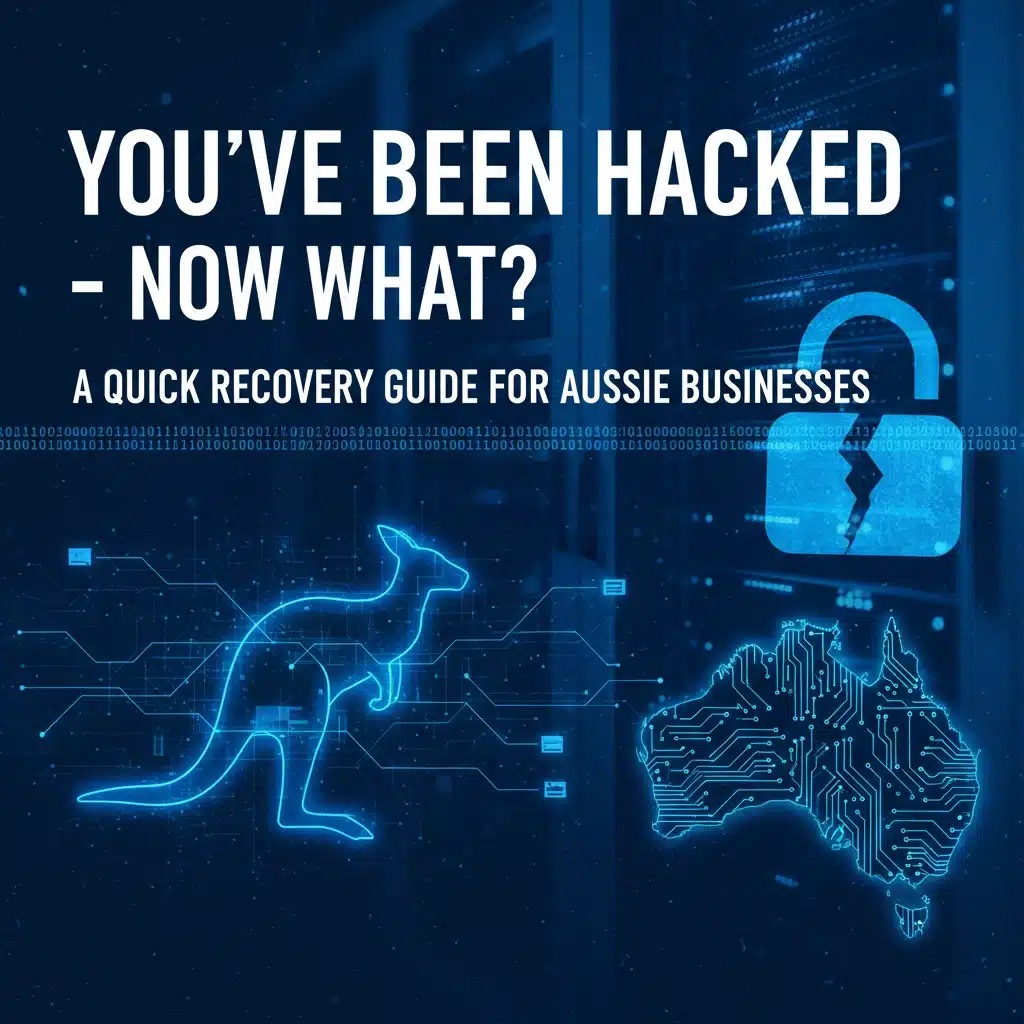Finding out your business has been hacked is every owner’s nightmare. Your heart’s racing, your mind’s spinning with worst-case scenarios, and you’re probably wondering where the hell to start. Take a deep breath – you’re not alone, and there’s a clear path forward.
Cyber attacks hit Australian businesses every 11 minutes according to recent statistics, so unfortunately, you’re in pretty common company. The good news? With the right response plan, most businesses can recover and come back stronger than before.
Step 1: Identifying the Compromise – Spot the Signs
Before you can fix the problem, you need to understand what you’re dealing with. Cyber attacks don’t always announce themselves with flashing red sirens (though ransomware certainly tries to).
Common signs your business has been compromised:
- Unusual network activity or slow internet speeds
- Files you can’t access or have strange extensions
- New programs installed without your knowledge
- Staff reporting password login issues
- Customers mentioning suspicious emails “from” your company
- Bank accounts showing unauthorised transactions
- Your antivirus going haywire with alerts
Don’t ignore your gut feeling either. If something feels off with your systems, it probably is. Australian cybercriminals are getting more sophisticated, but they still leave digital fingerprints.
Step 2: Immediate Containment – Stop the Bleeding
Once you’ve confirmed a breach, your first priority is damage control. Think of this like a fire in your office – you need to contain it before it spreads to the whole building.
Your immediate containment checklist:
Isolate affected systems immediately. Disconnect compromised computers from your network and the internet. Yes, this might disrupt operations temporarily, but it’s better than letting hackers access more of your data.
Don’t turn off infected computers – this might destroy valuable evidence that authorities or IT professionals need to track down the attackers.
Change passwords on all critical accounts – start with admin accounts, banking, and any cloud services. Use strong, unique passwords for each account.
Contact your bank if you suspect financial information has been compromised. Most Australian banks have 24/7 fraud hotlines and can put immediate holds on suspicious activity.
Preserve evidence by taking photos of any ransom messages, unusual files, or error messages. This documentation will be crucial for recovery and potential law enforcement involvement.
Step 3: Reporting – Your Legal and Practical Obligations
In Australia, you’ve got specific reporting requirements that you need to handle quickly. Don’t worry – these agencies are there to help, not punish you.
Report to the Australian Cyber Security Centre (ACSC)
Head to cyber.gov.au and use their ReportCyber tool. The ACSC provides free assistance to Australian businesses and can offer specific advice for your situation. You can also call their hotline at 1300 CYBER1 (1300 292 371).
Consider Notifiable Data Breaches (NDB) requirements
If personal information has been accessed or disclosed, you might need to notify the Office of the Australian Information Commissioner (OAIC) within 72 hours. This includes customer details, employee records, or any personal data your business holds.
Contact your cyber insurance provider
If you’ve got cyber insurance (and if you don’t, put that on your post-recovery to-do list), notify them immediately. Many policies require prompt reporting to maintain coverage.
Internal reporting
Make sure your entire team knows about the breach. Create a simple communication plan so everyone’s on the same page about what happened and what they should do differently while you recover.
Step 4: The Clean-Up – Getting Back to Business
This is where the real work begins. Cleaning up after a cyber attack isn’t just about deleting suspicious files – you need to rebuild trust in your systems from the ground up.
Start with a complete system assessment
Before you restore anything, you need to understand the full scope of the damage. Run comprehensive antivirus scans on all systems, but remember that sophisticated attacks might hide from standard detection tools.
Wipe and rebuild infected systems
Here’s the hard truth: the only way to be 100% certain that malware is gone is to completely wipe affected systems and rebuild them from scratch. This means:
- Backing up any clean data (scan it first!)
- Reformatting hard drives
- Reinstalling operating systems from clean media
- Restoring applications from original sources
- Restoring data from clean, verified backups
Restore from clean backups
This is why having good backup procedures matters. Only restore data from backups that you’re certain were created before the attack began. Test restore a small amount first to make sure your backups aren’t infected too.
Update everything
Install all available security updates for your operating systems, applications, and security software. Many attacks exploit known vulnerabilities that have already been patched.
Step 5: Ongoing Monitoring – Staying Vigilant
Recovery doesn’t end when your systems are back online. You need to keep watching for signs that the attackers might still be lurking or might try to return.
Implement enhanced monitoring
Set up additional logging and monitoring tools to watch for suspicious activity. Many attacks have multiple phases, and cybercriminals often return to networks they’ve previously compromised.
Regular security scans
Schedule daily antivirus scans and weekly vulnerability assessments. Make this part of your routine, not just something you do during a crisis.
Staff education and awareness
Your team is your first line of defence. Provide cybersecurity training that covers recognising phishing emails, safe browsing habits, and what to do if they suspect something’s wrong.
Review and update security policies
Use this experience to strengthen your cybersecurity practices. Update your incident response plan based on what you’ve learned, and make sure everyone knows their role in keeping the business secure.
Prevention – Making Sure This Doesn’t Happen Again
Nobody wants to go through this nightmare twice. Here’s how to build stronger defences for your Aussie business:
Backup strategy overhaul
Implement the 3-2-1 backup rule: three copies of critical data, on two different types of media, with one copy stored offline. Test your backups regularly – a backup you can’t restore is useless.
Multi-factor authentication everywhere
Enable MFA on all business accounts, especially email, banking, and cloud services. Yes, it’s a bit more annoying to log in, but it stops most attacks in their tracks.
Regular security assessments
Consider annual penetration testing or security audits. It’s much cheaper to find vulnerabilities before the bad guys do.
Cyber insurance
If you don’t have it already, get comprehensive cyber insurance. Look for policies that cover business interruption, data recovery costs, legal fees, and customer notification expenses.
When to Call in the Professionals
Sometimes, you need to admit that this is bigger than what you can handle internally. Don’t let pride put your business at further risk.
Consider professional help if:
- The attack affects critical business systems
- You’re not confident in your ability to completely remove the threat
- You’re dealing with ransomware or advanced persistent threats
- You need to maintain operations while cleaning infected systems
- You’re facing regulatory requirements or legal implications
At Cloud Computer Company, we’ve helped countless Australian businesses recover from cyber attacks and implement stronger security measures. Our managed IT services can help prevent attacks before they happen, but we’re also here when you need emergency response and recovery support.
The Road to Recovery
Getting hacked is traumatic, expensive, and disruptive, but it doesn’t have to be the end of your business. Most Australian companies that follow a proper incident response plan bounce back stronger than before.
Remember, cyber attacks are a crime that happened to you – you’re not at fault for being targeted. Focus on recovery, learn from the experience, and build better defences for the future.
The most important thing right now is to stay calm, follow the steps systematically, and don’t hesitate to ask for help when you need it. Your business will get through this, and you’ll be better prepared for whatever comes next.
Need immediate help with a cyber security incident? Contact Cloud Computer Company for emergency IT support and recovery assistance across Australia



